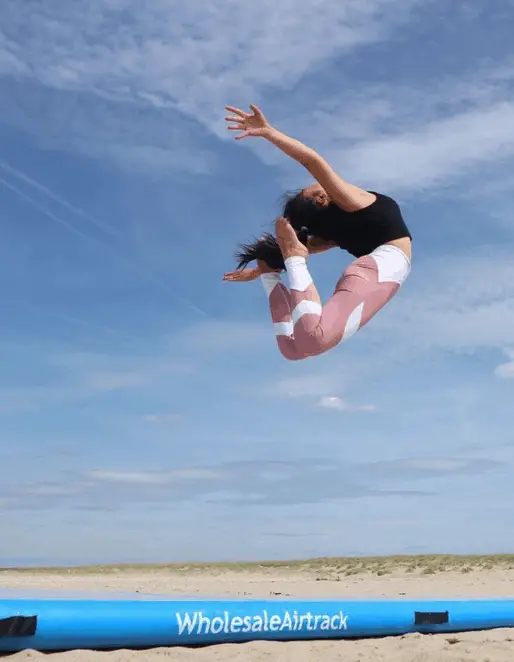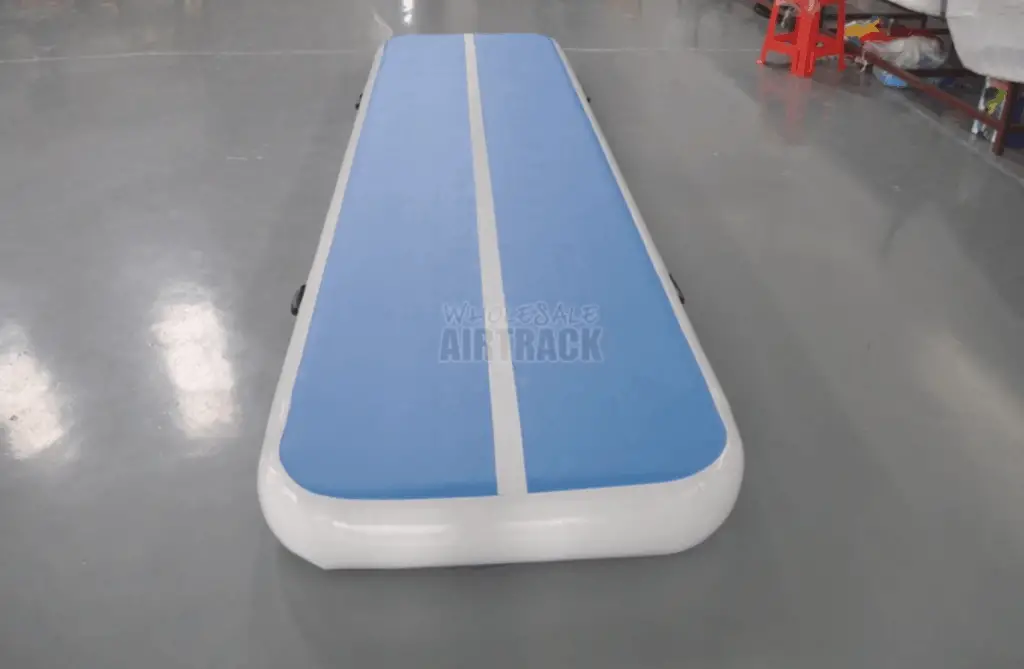Air tracks are most often used for gymnastics, but their usefulness reaches out to so many other sports as well. Since air tracks can be so long, one of the hardest things about them can sometimes be finding a spot to set one up.
Can air tracks be put on grass, concrete or Other Surfaces? Yes, air tracks can be set up on grass, concrete, sand and even water. They work on almost any surface that has sufficient room. Some of these surfaces may require minor prep work to make sure that your air track is not damaged while in use.
Much of this depends on what your air track is made of since some materials are more durable than others. An air track that is designed solely for indoor use will need extra protection if you want to set it up outdoors.
Notes On Air Tracks
There are many different types of air tracks of all different sizes for you to choose from. When you are setting one up, however, one of the most important things to consider is what your air track is made out of.

Air tracks that are lightweight are made mostly for indoor use. These air tracks are much more delicate and should preferably not be set up outdoors at all. Air tracks that are thicker are much better for outdoor use.
Not only are these air tracks more durable, but most of them also have a coating of UV protection. If you place an air track outdoors that does not have UV protection, then the sun will damage your track over time, depending on just how much sun it gets.
Therefore, you should verify whether or not your air track has this before you decide to put it outside. While you can add a UV protection layer to an air track you already have, this can be a lot of trouble, and it is not free.

Another difference in some of the fabrics that air tracks can be made out of is that some can be waterproof. A waterproof air track allows you to set up your air track near your pool. This can allow you to have fun doing things such as tumbling routines that end with you doing a flip into the pool.
A few air track models can even be set up directly on the water, though this is more for fun than for practical training since the track will shift some with the water. However, many air tracks are not made to be waterproof at all, so make sure you check before getting your air track wet.
Setting Up Your Air Track On Various Surfaces
Setting up your air track outside on grass or concrete is obviously going to be a little different than it is to set up an air track indoors on a hard or carpeted floor. Most mats have a non-slip surface for the bottom to prevent it from sliding while you practice.
If your grass does not contain any burrs or thorns in it, then it is perfectly safe to set it up on grass exactly the same way you do on a regular floor. Just make sure that there are no sticks, toys, pine cones, or anything else that could damage the air track.
As for setting up your air track on concrete, this depends on how smooth the concrete is and how durable your air track is. For example, a durable air track made for outdoor use could likely be set up on rough concrete safely.
However, an air track made for indoor use might not be able to take the roughness as well. In this latter case, a protective layer must be put down first. This protective layer can be a tarp or something similar just as long as it is big enough to completely cover the whole area of ground underneath your air track.
Likewise, if the area you want to set up your air track at has lots of small rocks or other possible dangers, you should put a protective layer down first. While plastic can be used as a protective layer, plastic also has the tendency to slip.
It is possible to set up an air track virtually anywhere by using more than one layer of protection. An old blanket, for example, does make a nice cushion. Just be sure to verify how likely your air track is to slip before you get into your training.
Notes On Setting Up Your Air Track
No matter where you set up your air track, some general rules will stay the same. For starters, before you even get your air track out, you should always clear the area where you plan on setting it up.
The area that will be beneath your air track should be as smooth and flat as possible. Air tracks that are designed by indoor use, in particular, need an extra-smooth surface to lay on. These do not even need something that is sharp to puncture them.
Keep in mind that as you bounce around on top of your air track that there is a slight shifting of the air track beneath you. This can allow even a dull, rounded stone to potentially wear on the threads of an indoor air track.
Next, you want more space cleared than just the space needed to set up your air track. Even though most gymnastics air tracks have lines on them to help you with orientation, you can still end up off of the track. This is especially true if you take a nasty tumble.
That said, when you are clearing a space for your air track, you should clear a good distance on all sides of your track. That way, if you end up off of the track, you do not hit anything and end up hurting yourself.
Finally, one last thing you should make note of when setting up your gymnastics air track is heat. If heat is applied or trapped up against a certain area of your air track, it can cause damage. The heat will weaken the material of the track and can cause the fabric there to bulge or form a weak spot.
Final Thoughts
Air tracks are something that you can take everywhere with you. While they are undoubtedly extremely useful, sometimes it can be difficult, if not seemingly impossible, to find a good spot to set one up at. So, sometimes knowing that you can still set your track up, even on a less than ideal surface, can help encourage you to bring your air track along when you otherwise would have left it at home.
As for placing a protective layer underneath your air track, this can be done even if you know there is nothing there to protect your track from. True, this can make your mat more prone to slipping on you, but this is only if what you are using is slippery itself.
It is far better to get into a habit of placing that protective layer down when you don’t think you need it than to forget to place it down when you do need it. This also helps keep your air track clean when you take it outdoors and put it on the grass.
Leaving your air track out on the grass in one spot too long can kill the grass, which can get slimy with enough time. This slime then needs cleaned off if you want to take your air track indoors, which can be a time-consuming process.
You can easily avoid having to clean this slime off of your air track by not placing your track directly on the grass. More than that, slime and moisture is not good for an air track, even one that is made to be waterproof, and can potentially cause mildew.
An air track can trap moisture in between itself and any protective layer that you put it on. So, you should move your air track around a little and take care of any problems like this before your air track gets mildew or mold on it.

